To the Celts, the stag symbolized wild nature. Its alertness, speed and its aggression and potency during the rutting season made it an object of reverence, and its spreading, tree-like antlers seemed to epitomize the forest. Often the antlers are emphasized in iconography.117 At Colchester (Essex), a small bronze stag was dedicated to Silvanus Callirius at a Romano-Celtic shrine.118 The Celtic soubriquet means 'King of the Woodland'. The magnificent stag figurine from the late Iron Age hoard of Neuvy-en-Sullias (Loiret) is depicted with his antlers in velvet,119 signifying that it is late springtime. Indeed, the autumnal shedding and spring growth of a stag's antlers may well have endowed the creature with a cyclical, seasonal symbolism, similar to that of deciduous trees.
The iconography of stags was closely associated with that of hunting. At Camonica Valley,120 the divine stag was revered and hunted at the same time. He was also the companion of the solar god and his antlers were sometimes represented as curved round to form a circular, rayed sun.121 The divinity of the stag at Camonica is powerfully indicated on a carving which dates to the beginning of the Iron Age in the seventh century BC,122 and depicts a being who is half-man, half-stag. This image may portray the stag-god in metamorphosis, in the same way as Cernunnos himself (pp. 231-4).
The Romano-Celtic hunters display an ambivalent attitude to their stag victims (see also chapter 3): the sculpture at the high mountain sanctuary of Le Donon in the Vosges shows a god who is both hunter and benefactor of the forest and its inhabitants.123 He stands, carrying the fruits of the wild woodland - pine-cones, nuts and acorns - in an open bag under his arm. He wears the pelt of a wolf as a cloak, his boots are ornamented with the heads of animals, and he carries the tools of his hunting activity: a long knife, a chopper and a spear. He is therefore a hunter, who kills the forest-dwellers and who wears the skins of his victims. But beside him is a stag, apparently a fearless companion on whose antlers the god rests his hand, in apparently benevolent protection. The deity is thus both slayer and guardian of the forest-dwellers; the stag is both victim and associate of the nature-god. Other hunter-divinities show the same ambivalence to their prey: Cocidius was a local god of north Britain, equated sometimes with the Roman Mars, sometimes with Silvanus. On a sculpture from Risingham, he appears as a hunter with his dog: nearby a family of deer - stag, doe and fawn - is grazing unconcernedly in the presence of Cocidius. The forest is represented by trees laden with acorns.124 The simple carving at Treclun in Burgundy shows a similar scene, with dogs and stags.125
Cernunnos: the stag-god
The veneration of the stag and its close association with the supernatural led to the concept of a god whose identity could be represented by an image which blurred the boundaries between man and animal. That beasts - the stag in particular - were themselves considered divine is shown above all by the iconography of a deity who, though he is depicted in anthropomorphic form, none the less had zoomorphic features (figures 7.18, 8.20, 8.21). He was Cernunnos, the Horned One, distinguished by his possession of antlers. He was a powerful god, whose potency was enhanced by his adoption of the essence of his animal associate. Cernunnos's name appears only once, on a first-century AD stone at Paris, which depicts the head of an elderly, balding, bearded man wearing antlers with torcs hanging from them,126 and with stags' ears. But the god himself was venerated before this period: at Camonica Valley, a site whose rock art abounds in stag imagery, a fourth-century BC image depicts a large standing figure of a god with antlers and torcs.127 An Iron Age coin dating to about AD 20 depicts Cernunnos wearing antlers and with what seems to be a solar wheel symbol between them (figure 8.20).128 On a late pre-Roman bronze statuette at Bouray (Seine-et-Oise), a god wearing a torc sits cross-legged on the ground: he bears no antlers but the fact that he possesses hooves is indicative of his stag symbolism.129 The most important representation of Cernunnos dating from the free Celtic period is on the Danish Gundestrup Cauldron,130 where an antlered deity sits cross-legged, one torc round his neck, another in his
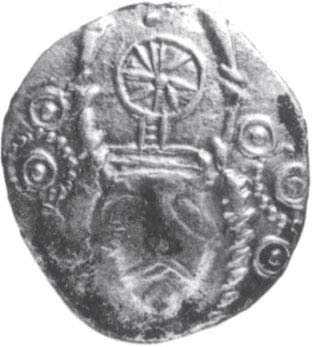
Figure 8.20 Celtic silver coin with the head of Cernunnos, a sun symbol between his antlers, c. AD 20, Petersfield, Hampshire. By courtesy of the National Museum of Wales.
Hand, accompanied by his stag, a ram-horned serpent and multifarious other creatures, both naturalistic and fantastic (figure 6.18).
Cernunnos flourished in the Romano-Celtic period, when he was represented by a large number of images, mainly in north-central Gaul, but also further west, at Saintes and even among the Dobunni of southwestern Britain.131 Many of the free Celtic and Romano-Celtic images have common characteristics: often the god is shown seated in a cross-legged position, as at Gundestrup, Reims (figure 8.21)132 and Sommerecourt.133 This may not be significant, since such a position would be natural and comfortable for people accustomed to sit on the floor, as, indeed, was observed by classical observers of the Celts.134 Frequently the god is associated with torcs, sometimes two; he is often accompanied by one or more ram-horned snakes (see pp. 227-8); he has a stag and other animal associates.
The images of Cernunnos at Sommerecourt (Haute-Marne) and Etang-sur-Arroux near Autun,135 the first of stone and the second of bronze, have two shared features of considerable interest for the interpretation of Cernunnos's cult: both show the god feeding horned serpents from bowls of food, and the animals curl themselves intimately round their benefactors. Both images have holes in their heads for the insertion and removal of separate antlers. This could be especially meaningful in that we might envisage a symbolism, reflecting the seasonal cycle of stags themselves, whereby the antlers were perhaps removed in the autumn and replaced in spring.
The Burgundian tribes, the Aedui and the Lingones, worshipped a Cernunnos who could be perceived as three-headed. The bronze figurine at Etang has one main head and two small subsidiary heads, one at each side. On a sculpture at Nuits-Saint-Georges, Cernunnos is three-faced; he is part of a triad of divinities.136 On a carving at Beaune, he is again one of three deities, but here it is one of his companions who is three-headed rather than the stag-god himself.137
Cernunnos symbolizes abundance and prosperity and is the guardian of wild nature. He is Lord of Animals, who is often seen surrounded by many different creatures, a Noah-like figure of benevolence. This happens on the iconography of Gundestrup, Nuits-Saint-Georges and Beaune. The stele at Reims (figure 8.21) depicts Cernunnos feeding a
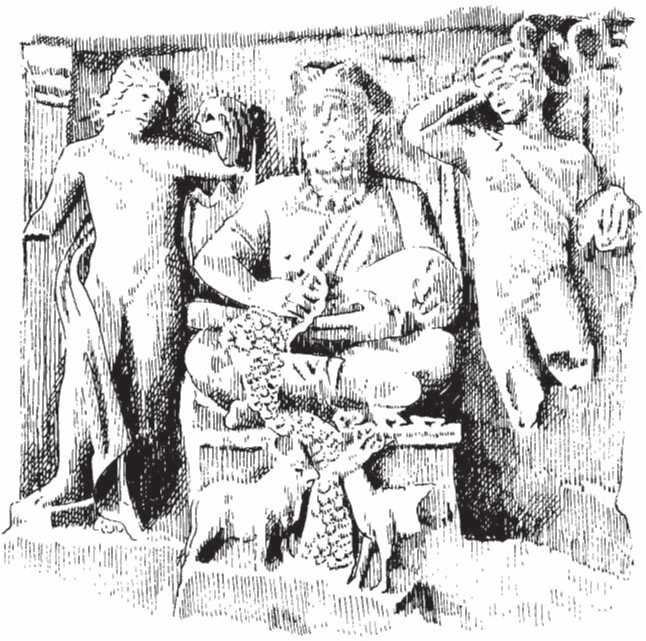
Figure 8.21 Stone relief of Cernunnos seated between Apollo and Mercury. Beneath the antlered god are a bull and stag eating from a sack of coins or grain, Reims, France. Height: 1m 30cm. Paul Jenkins.
Stag and a bull from a bag of grain or coins; the god feasts horned snakes at Sommerecourt and Etang. At Cirencester (figure 7.18), two horned serpents rear up to eat from open bags by Cernunnos's ears.138 The interweaving of god and serpents noted on the Gaulish monuments is even closer at Cirencester, as we have seen, where the snakes actually form Cernunnos's legs. The stag-god again has a purse on the image at Vendoeuvres.139 Here there is an interesting variation on the snake symbolism in that the two reptiles flanking the stag-god have human faces, as if they have escaped the limitations of realism, just as Cernunnos himself has done. The role of the god as lord of natural abundance and fertility is extended to the role of healing: he was venerated at such healing sanctuaries as Neris-les-Bains.140 At Reims, Cernunnos is flanked by the healer-god Apollo and the Celtic Mercury, a god of commercial success.141
It is possible that Cernunnos was a skin-turner or shape-shifter, able to vary his outward form from human to animal at will. His semizoomorphic images may present the god as in mid-change, to remind his worshippers of his particular powers, born of his affinity with the animal world. Many of the Norse gods could change form in this way: Loki, for instance, became at different times a mare, a hawk, a salmon and a seal.142
The horned ones: gods or devils?
Horns are obvious representations of aggression, of the ability to inflict pain and destruction. Although horns are not sex-specific, they also tend to symbolize the pugnacity displayed by male animals, especially in rut, and thus virility and fertility in general.
Horned images appear in Celtic and, indeed, in pre-Celtic iconography in Europe (figure 8.22). Certain animals, which have no horns in reality, were endowed with these attributes in the imagination of ancient European artists: horned birds, for instance, are common in Urnfield (later Bronze Age) imagery. We have already met Celtic horned serpents; horses could also be depicted with horns: a depiction dating to the fourth or third century BC, carved at Mouries in Provence, shows a triple-horned horse. The heads decorating the late Iron Age Capel Garmon firedog (figure 5.13) are horned, like bulls, but resemble horses. One Gaulish image of a boar sprouts three horns. In the earlier discussion of bull imagery, allusion was made to the triple-horned bull, a common Romano-Celtic image. In all these instances, horns appear to have been added in order to endow the animals with sanctity, an element of the supernatural, and virile, aggressive force.
Anthropomorphic horned images formed part of the European craftsman's repertoire as early as the Bronze Age, when Danish male
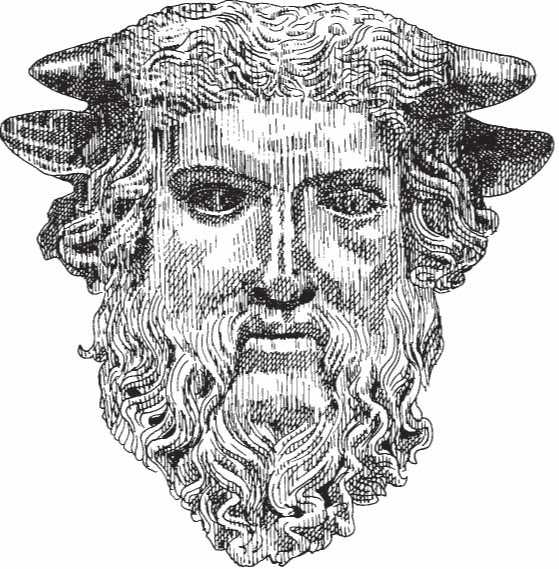
Figure 8.22 Bronze bull-horned human head, first century AD, Lezoux, Puy-de-Dome, France. Paul Jenkins.
Figurines were adorned with horns.143 These beings are ithyphallic and the presence of the horns probably enhanced their virility symbolism. PreRoman Celtic art endowed many half-human, half-divine images with horns: one of the rare representational stone carvings of the fifth to fourth century BC consists of a statue of a male deity at Holzerlingen in Germany.144 The sculpture is a plain block of stone with a belt at the waist and the arms crossed on the chest, but the Janiform head bears a double-horned crown. Iron Age metalwork is sometimes decorated with horned figures: an example is the bucket-escutcheon at Boughton Aluph (Kent),145 which is in the form of a male head with jutting bull's horns, a variation on the bullheaded bucket-mounts which are so common in the later Iron Age.
The association between horns and aggression is demonstrated by the use of horns to adorn Celtic helmets (figure 4.16): this tradition is mentioned by Diodorus Siculus,146 who comments that Celtic warriors wore helmets decorated with animal crests or horns, to increase their stature and the ferocity of their appearance in battle. We can see this in iconography, for example on
The Gundestrup Cauldron plate (figure 4.5) with its image of the wheel-god attended by a small figure wearing a horned helmet. Similarly, the carvings of Celtic armour in the early first century AD on the Orange Arch147 include bull-horned helmets (figure 6.6). While horned images are relatively uncommon in Romano-Celtic Continental contexts, horned warrior-deities were popular images in Britain, especially in the Brigantian north (figures 8.23, 8.24).148 I will take just one example of many, a small, roughly incised relief at Maryport in Cumbria.149 He is naked, with a spear in his right hand, a shield in his left. What is especially interesting is the intense phallic symbolism of the piece: the god is ithyphallic and even his nose resembles
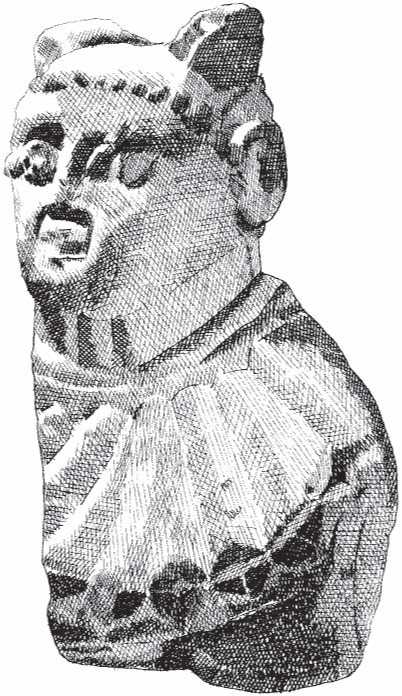
Figure 8.23 Stone bust of horned god, Moresby, Cumbria. Paul Jenkins.
An erect phallus, while the horns themselves are also phallic in form. Here war, destruction, aggression, virility and fecundity are all present in this one simple yet concentrated image.
Horns were not the sole prerogative of the war-gods, though they were above all associated with aggression. Certain divinities could be endowed with horns on certain occasions, to stress particular aspects of their natures. The Celtic Mercury was occasionally given horns: the shrine at West Uley in Gloucestershire was dedicated to Mercury.150 Most of the many images from the sanctuary present the god in his usual classical guise but one depicts him with a prominent pair of horns. The stylized relief of Mercury found in a well at Emberton (Bucks.) presents an interesting example of an ambiguity in imagery which may be deliberate: the Graeco-Roman god often wears a petasos or cap with small wings sprouting from it. The Emberton Mercury bears excrescences on his head, but the carving is so stylized that it is difficult to tell whether these are horns or wings. In my opinion, this feature may well have been left deliberately vague and imprecise by the Celtic artist: the significance of the image perhaps lay in the eye of the beholder, a Roman seeing wings and a Celt horns. Physically, the difference between small wings and horns is very little, but the conceptual or symbolic shift is enormous.
Horns were given to the goddesses only infrequently, although horned female deities are known, for instance at Richborough in Kent and Icklingham in Suffolk.151 The possession of horns by gods who were not warriors was probably meant to emphasize aspects of the fertility or prosperity of their cults. The addition of the attributes of a bull, ram or goat to an anthropomorphic image gave it the power of that animal, as surely as Cernunnos's antlers endowed him with the force of the wild woodland and the qualities of its most prominent creature, the stag. What is clear is that the horned beings did not represent the power of evil. In Christian contexts, horns have been associated with Satan. The reasons for this are interesting but strictly outside the scope of this book. A multihorned dragon is equated with Satan in chapter 12 of the Book of Revelation. Medieval Christians perceived the Devil as horned and hooved, perhaps because of the classical Pan, a lascivious nature-god who would be well known to medieval classicists. It may have been that the sexual excesses ascribed to this god, or the essence of unacceptable paganism, were epitomized, in Christian eyes, by the cults of animals. But certainly, as far as the Celts were concerned, evil connotations were entirely absent from their horned deities, although it is true that sexuality implied by fertility was undoubtedly part of the symbolism of the horned gods. The Celtic worshipper perceived horned or antlered divinities as bringers of
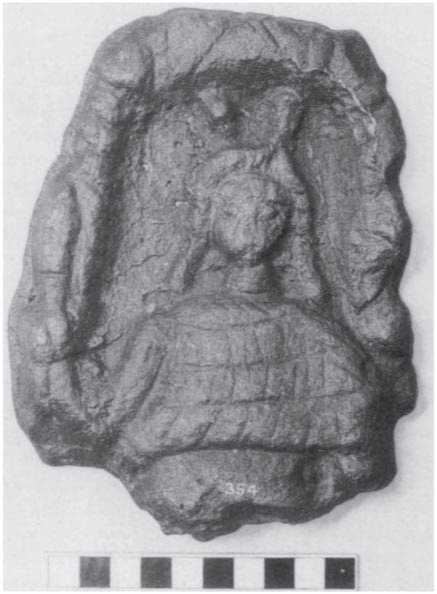
Figure 8.24 Lead plaque of horned god, Chesters, Northumberland. Miranda Green.
Abundance, where the growth of crops and increase of livestock were crucial to survival, and where infant mortality and disease were a constant threat. Moreover, the horned warrior-gods were venerated not simply as destroyers but also as protectors or guardians, not just against enemies in battle but against all the ills of humankind. The horned gods of north Britain152 combined elements of aggression (perhaps against the Roman conquerors) with beneficent guardianship of their people. Ironically, the protective character of the Celtic horned and antlered gods bears a far greater resemblance to the beneficence of Christ than to the image of the Devil.




 World History
World History









